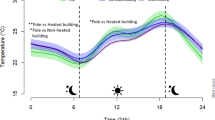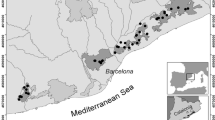Abstract
Habitat loss and forest fragmentation are currently substantially reducing the availability of natural bat roosts worldwide. However, since bat populations have been recognized as important ecosystem service providers, bat boxes have become one of the most popular measures employed to protect them. Evidence exists that in arid regions bat boxes act as ecological traps due to abrupt rises in summer temperatures. Several reported mortality events highlight the lack of appropriate guidelines in temperate areas, which might be putting bat conservation in jeopardy. We aimed to explore which bat box features might cause mortality so we compare temperatures in bat boxes, modelling the influence of the orientation and model, and quantifying the risk of extreme heat episodes. A total of 797 overheating events were recorded during a bat-box monitoring program in Catalunya (2014–2015). In 2016, we compared temperatures in up to 15 models side-by-side in the Ebro Delta Natural Park. Bat-box model and orientation clearly affected the number of overheating events. Black-coloured and south-facing boxes recorded the highest temperatures, including the most popular models, with temperatures over 40 °C. The number of overheating events was clearly dependent on the bat-box model. For example, a new model manufactured from rice chaff did not experience any overheating event in contrast with the 2F model that recorded over 50. We do not recommend the use of black boxes in south-facing sites in warm areas. In fact, observed internal temperature gradients suggest that complex boxes may help counteract the effects of overheating. We highlight the importance of taking microclimate characteristics into consideration when setting up a bat-box scheme.






Similar content being viewed by others
References
Alcalde JT, Martínez I, Zaldua A, Antón I (2017) Conservación de colonias reproductoras de muciélagos cavernícolas mediante refugios artificiales. Barb J Bat Res. https://doi.org/10.14709/BarbJ.10.1.2017.02
Ancillotto L, Santini L, Ranc N et al (2016) Extraordinary range expansion in a common bat: the potential roles of climate change and urbanisation. Sci Nat 103:8. https://doi.org/10.1007/s00114-016-1334-7
Ancillotto L, Ariano A, Nardone V et al (2017) Effects of free-ranging cattle and landscape complexity on bat foraging: implications for bat conservation and livestock management. Agric Ecosyst Environ 241:54–61. https://doi.org/10.1016/j.agee.2017.03.001
Barnosky AD, Matzke N, Tomiya S et al (2011) Has the Earth’s sixth mass extinction already arrived? Nature 471:51–57. https://doi.org/10.1038/nature09678
Bartonicka T, Rehak Z (2007) Influence of the microclimate of bat boxes on their occupation by the soprano pipistrelle Pipistrellus pygmaeus: possible cause of roost switching. Acta Chiropterologica 9:517–526. https://doi.org/10.3161/1733-5329(2007)9%5b517:IOTMOB%5d2.0.CO;2
Bates D, Maechler M, Bolker B, Walker S (2017) Package “lme4.” R. Packag. version 1.1-13
Battin J (2004) When good animals love bad habitats: ecological traps and the conservation of animal populations. Conserv Biol 18:1482–1491
Bellard C, Bertelsmeier C, Leadley P et al (2012) Impacts of climate change on the future of biodiversity. Ecol Lett 15:365–377. https://doi.org/10.1111/j.1461-0248.2011.01736.xs
Berthinussen A, Richardson OC, Altringham JD (2008) Bat Conservation of interventions. Global evidence for the effects of interventions. Pelagic Pulishing, Exeter
Brack V, Stihler CW, Reynolds RJ, et al (2002) Effect of climate and elevation on distribution and abundance in the mideastern united states. Indiana Bat, pp 21–28
Brittingham MC, Williams LM (2000) Bat boxes as alternative roosts for displaced bat maternity colonies. Wildl Soc Bull 28:197–207
Burnham KP, Anderson DR (2002) Model selection and multimodel inference. Spinger, New York
De Paz Ó, De Lucas J, Arias JL (2000) Cajas refugio para quirópteros y estudio de la población del murciélago orejudo dorado (Plecotus auritus Linneo, 1758) en un área forestal de la provincia de Guadalajara. Ecología 14:259–268
Delignette-Muller M-L, Dutang C (2017) Package “fitdistrplus.” R. Packag. version 1.0-9
Dillingham CP, Cross SP, Dillingham PW (2003) Two environmental factors that influence usage of bat houses in managed forests of Southwest Oregon. Northwest Nat 84:20–23
Dirzo R, Young HS, Galetti M et al (2014) Defaunation in the Anthropocene. Science 345(6195):401–406
Dodds M, Bilston H (2013) A comparison of different bat box types by bat occupancy in deciduous woodland, Buckinghamshire, UK. Conserv Evid 10:24–28
Doty AC, Stawski C, Currie SE, Geiser F (2016) Black or white? Physiological implications of roost colour and choice in a microbat. J Therm Biol 60:162–170. https://doi.org/10.1016/j.jtherbio.2016.07.015
Flaquer C, Puig-Montserrat X (2012) Proceedings of the International Symposium on the Importance of Bats as Bioindicators. In: Puig-Montserrat X (ed) Flaquer C. Museum of Natural Sciences Edicions, Granollers, pp 1–95
Flaquer C, Torre I, Ruiz-jarillo R (2006) The value of bat-boxes in the conservation of Pipistrellus pygmaeus in wetland rice paddies. Biol Conserv 1:223–230. https://doi.org/10.1016/j.biocon.2005.09.030
Flaquer C, Puig-Montserrat X, López-Baucells A et al (2014) Could overheating turn bat boxes into death traps? Barb J Bat Res 7:46–53. https://doi.org/10.14709/BarbJ.7.1.2014.08
Goldingay RL (2015) Temperature variation in nest boxes in eastern Australia. Aust Mammal 37:225–233. https://doi.org/10.1071/AM14040
Griffiths SR, Rowland JA, Briscoe NJ et al (2017) Surface reflectance drives nest box temperature profiles and thermal suitability for target wildlife. PLoS ONE. https://doi.org/10.1371/journal.pone.0176951
Jones G, Jacobs DS, Kunz TH et al (2009) Carpe noctem: the importance of bats as bioindicators. Endanger Species Res 8:93–115. https://doi.org/10.3354/esr00182
Kasprzyk K, Ruczynski I (2001) The structure of bat communities roosting in bird nest boxes in two pine monocultures in Poland. Folia Zool 50:107–116
Kerth G, Weissmann K, König B (2001) Day roost selection in female Bechstein’s bats (Myotis bechsteinii): a field experiment to determine the influence of roost temperature. Oecologia 126:1–9. https://doi.org/10.1007/s004420000489
Korine C, Adams R, Russo D, Fisher-Phelps M, Jacobs D (2016) Bats and water: anthropogenic alterations threaten global bat populations. In: Voigt C, Kingston T (eds) Bats in the Anthropocene: conservation of bats in a changing world. Springer, Cham
Kottek M, Grieser J, Beck C et al (2006) World Map of the Köppen-Geiger climate classification updated. Meteorol Zeitschrift 15:259–263. https://doi.org/10.1127/0941-2948/2006/0130
Lenth R, Love J (2017) Package “lsmeans.” R. Packag. Version 2.27-2
Loeb SC, Winters EA (2013) Indiana bat summer maternity distribution: effects of current and future climates. Ecol Evol 3:103–114. https://doi.org/10.1002/ece3.440
Lopez JE, Vaughan C (2004) Observations on the role of frugivorous bats as seed dispersers in Costa Rican secondary humid forests. Acta Chiropterologica 6:111–119. https://doi.org/10.3161/001.006.0109
López-Baucells A, Puig-Montserrat X, Torre I et al (2016) Bat boxes in urban non-native forests: a popular practice that should be reconsidered. Urban Ecosyst. https://doi.org/10.1007/s11252-016-0582-9
López-Baucells A, Casanova L, Puig-Montserrat X et al (2017) Evaluating the use of Myotis daubentonii as an ecological indicator in Mediterranean riparian habitats. Ecol Indic 74:19–27. https://doi.org/10.1016/j.ecolind.2016.11.012
Lourenço SI, Palmeirim JM (2004) Influence of temperature in roost selection by Pipistrellus pygmaeus (Chiroptera): relevance for the design of bat boxes. Biol Conserv 119:237–243. https://doi.org/10.1016/j.biocon.2003.11.006
Luo J, Koselj K, Zsebok S et al (2014) Global warming alters sound transmission: differential impact on the prey detection ability of echolocating bats. J R Soc Interface 11:20130961. https://doi.org/10.1098/rsif.2013.0961
Molina-Freaner F, Eguiarte LE (2003) The pollination biology of two paniculate agaves (Agavaceae) from Northwestern Mexico: constrasting roles of bats as pollinators. Am J Bot 90:1016–1024
O’Shea TJ, Cryan PM, Hayman DTS et al (2016) Multiple mortality events in bats: a global review. Mamm Rev 46:175–190. https://doi.org/10.1111/mam.12064
Pérez-Zanón N, Sigró J, Ashcroft L (2016) Temperature and precipitation regional climate series over the central Pyrenees during 1910–2013. Int J Climatol. https://doi.org/10.1002/joc.4823
Puig-Montserrat X, Torre I, López-Baucells A et al (2015) Pest control service provided by bats in Mediterranean rice paddies: linking agroecosystems structure to ecological functions. Mamm Biol 80:237–245. https://doi.org/10.1016/j.mambio.2015.03.008
Rhodes M, Jones D (2011) The use of bat boxes by insectivorous bats and other fauna in the greater Brisbane region. In: Law B (ed) Biology and conservation of Australasian bats. Royal Zoological Society of New South Wales, Griffith University, Griffith, pp 424–442
Ruegger N (2016) Bat boxes—a review of their use and application, past, present and future. Acta Chiropterologica 18(1):279–299. https://doi.org/10.3161/15081109ACC2016.18.1.017
Russo D, Jones G (2015) Bats as bioindicators: an introduction. Mamm Biol 80:157–158. https://doi.org/10.1016/j.mambio.2015.03.005
Schlaepfer MA, Runge MC, Sherman PW (2002) Ecological and evolutionary traps. Trends Ecol Evol 17:474–480. https://doi.org/10.1016/S0169-5347(02)02580-6
Storer TI (1926) Bats, bat towers and mosquitos. J Mamm 7:85–90
Tájek P, Tájková P (2016) Occupancy of bat boxes in coniferous forests of western Bohemia (Czech Republic). Vespertilio 18:99–120
Threlfall CG, Law B, Banks PB (2012) Influence of landscape structure and human modifications on insect biomass and bat foraging activity in an urban landscape. PLoS ONE 7:e38800. https://doi.org/10.1371/journal.pone.0038800
Welbergen JA, Klose SM, Markus N, Eby P (2008) Climate change and the effects of temperature extremes on Australian flying-foxes. Proc R Soc B 275:419–425. https://doi.org/10.1098/rspb.2007.1385
Wickham H, Chang W (2016) Package “ggplot2.” R. Packag. version 2.2.1
Acknowledgements
We would like to thank all the different land owners who allowed us to place bat boxes on their properties and the protected areas that supported the project: Alt Pirineu, Aiguamolls de l’Empordà and Delta de l’Ebre natural parks of the Generalitat the Catalunya; Serralada de Marina and Montnegre and el Corredor natural parks of the Diputació de Barcelona Natural Parks Network; Mas d’en Gil wineries (Priorat) and Recaredo-Celler Credo wineries (Penedès); Roques Blanques ALTIMA company (Collserola Natural Park) and Nous Calzada Company (Aitona). We would also like to thank Oriol Massana for the pictures of some of the bat boxes and Marta Goula for comments on previous versions of the manuscript. Funding for AL-B was provided by the Portuguese Foundation for Science and Technology (PD/BD/52597/2014). Additional funding for the purchase of bat boxes was provided by the Montnegre and Corredor Natural Park, Oryx (natural history suppliers in Barcelona) and Schwegler (bat wood-concrete boxes manufacturer).
Author information
Authors and Affiliations
Corresponding author
Additional information
Communicated by Kirsty Park.
Electronic supplementary material
Below is the link to the electronic supplementary material.
Rights and permissions
About this article
Cite this article
Martin Bideguren, G., López-Baucells, A., Puig-Montserrat, X. et al. Bat boxes and climate change: testing the risk of over-heating in the Mediterranean region. Biodivers Conserv 28, 21–35 (2019). https://doi.org/10.1007/s10531-018-1634-7
Received:
Revised:
Accepted:
Published:
Issue Date:
DOI: https://doi.org/10.1007/s10531-018-1634-7




